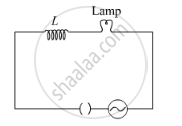Advertisements
Advertisements
प्रश्न
An electric bulb is designed to consume 55 W when operated at 110 volts. It is connected to a 220 V, 50 Hz line through a choke coil in series. What should be the inductance of the coil for which the bulb gets correct voltage?
उत्तर
Power consumed by the electric bulb, P = 55 W
Voltage at which the bulb is operated, V= 110 V
Voltage of the line, V = 220 V
Frequency of the source, v = 50 Hz
P = `V^2/R`
where R = resistance of electric bulb
`therefore R = V^2/P`
= `(110xx110)/55 = 220 Ω`
If L is the inductance of the coil, then total reactance of the circuit (Z) is given by,
`Z = sqrt(R^2 + (omegaL)^2`
=`sqrt((220)^2 + (100piL)^2` `( therefore omega = 2pif)`
Here, `omega` = angular frequency of the circuit
Now, current through the bulb, `I= V/Z`
∴ Voltage drop across the bulb, V = `V/ZxxR`
As per question,
`110 = (220xx220)/sqrt((220)^2 + (100piL)^2`
`rArr 220xx2 = sqrt((220)^2 + (100piL)^2`
`rArr (220)^2 + (100piL)^2 = (440)^2`
`rArr 48400 + 10^4 pi^2L^2 = 193600`
`rArr 10^4 pi^2 L^2 = 193600 - 48400`
`rArr L^2 = 145200/(pi^2 xx 10^4)`
= 1.4726
`rArr L = 1.2135 ≅ 1.2 H`
APPEARS IN
संबंधित प्रश्न
Ajit had a high tension tower erected on his farm land. He kept complaining to the authorities to remove it as it was occupying a large portion of his land. His uncle, who was a teacher, explained to him the need for erecting these towers for efficient transmission of power. As Ajit realised its significance, he stopped complaining.
Answer the following questions:
(a) Why is it necessary to transport power at high voltage?
(b) A low power factor implies large power loss. Explain.
(c) Write two values each displayed by Ajit and his uncle.
In a series LR circuit, XL = R and power factor of the circuit is P1. When capacitor with capacitance C such that XL = XC is put in series, the power factor becomes P2. Calculate P1/P2
A lamp is connected in series with an inductor and an AC source. What happens to the brightness of the lamp when the key is plugged in and an iron rod is inserted inside the inductor? Explain.

An A.C. generator generating an emf of ε = 300 sin (100 πt) V is connected to a series combination of 16μ F capacitor, 1 H inductor and 100 Ω resistor.
Calculate :
1) An impedance of the circuit at the given frequency.
2) Resonant frequency `f_0`
3)Power factor at the resonant frequency `f_0`.
For a given a.c., i = im sin ωt, show that the average power dissipated in a resistor R over a complete cycle is `1/2I_m^2` R .
In a circuit, containing a capacitor and an AC source, the current is zero at the instant the source voltage is maximum. Is it consistent with Ohm's Law?
A resistance is connected to an AC source. If a capacitor is included in the series circuit, will the average power absorbed by the resistance increase or decrease? If an inductor of small inductance is also included in the series circuit, will the average power absorbed increase or decrease further?
A series AC circuit has a resistance of 4 Ω and a reactance of 3 Ω. The impedance of the circuit is
Transformers are used ______.
Consider the situation of the previous problem. Find the average electric field energy stored in the capacitor and the average magnetic field energy stored in the coil.
What is the value of power factor for a pure resistor connected to an alternating current source ?
Answer the following question.
Show that an ideal inductor does not dissipate power in an ac circuit.
Quality factor and power factor both have the dimensions of ______.
The power factor of series LCR circuit when at resistance is
Which of the following quantities remains constant in a step-down Transformer?
The series combination of R, L, C is connected to an a.c. source. If the resistance is 3 and the reactance is 4, the power factor of the circuit is:
An inductor of reactance 1 Ω and a resistor of 2 Ω are connected in series to the terminals of a 6 V (rms) a.c. source. The power dissipated in the circuit is ______.
An alternating current I = 14 sin (100 πt) A passes through a series combination of a resistor of 30 Ω and an inductor of `(2/(5pi))` H. Taking `sqrt2` = 1.4 calculate the power factor of the circuit.
